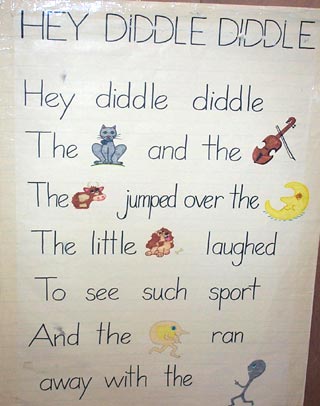Dear Annie,
Judy sure can write -- and the way she draw smiles is always spot-on, don't you think? I love those books.
When the girls were in the early grades, I used to volunteer at their school library, where I learned huge amounts about children's literature from the excellent librarian. One of the many habits she instilled in me was to avoid calling learn-to-read books easy readers -- because for those who use them, they're hard work. Calling them easy doesn't acknowledge the effort a child puts into it.
Both Lizzie and Mona were comfortable readers by the middle of first grade, but they arrived there on different paths. Learning to read is of course not something that one does all at once. Everything gets lined up over the course of years. From the start, children are doing a lot of listening: they learn how to make the sounds of words and distinguish among them. They can hear rhymes. Even before they know the alphabet, they learn that marks on paper are symbols representing other things. Rebus books, which put pictures in the place of some words, emphasize that connection. Here's a Rebus poster:
Lizzie connected with a phonics-based way of learning. It relies heavily on understanding the sounds of letters and understanding how some letters change when they're near other letters -- H or a silent E, for example. Your mother's wonderful books are phonics readers. It's the way most parents believe they learned. When Mona entered first grade, she was eager and impatient to learn to read. I will never forget her wailing at the end of her first day of school: "Sophie can read Go Dog Go and I can't!" She caught on right away to elements of what's sometimes called the whole language approach. She understood the phonics elements, and was capable of sounding out words, but she tackled the written word differently. This approach encourages readers to take cues from illustrations and what one knows about the book before one starts reading. The way I saw it work with Mona was that she'd look at the first letter or two of a word and make what was basically an educated guess. If she couldn't figure it out quickly, she'd slow down and sound out. It wasn't intuitive for us as parents -- and she made a lot of mistakes at first, but it got the job done. On the first day of second grade she chose Charlotte's Web as her first reading assignment. Here's a slightly longer definition of the different approaches -- it's on a commercial website, but the basic description seems pretty good. The one-vs-the-other doesn't ring true for our experience. It feels more like there's a range and kids learn by mixing different amounts of each method.
When the girls were learning, I asked your mother, the reading specialist, about these approaches. My recollection of her response (we need to hear from you, Judy!) was something like a shrug and a "whatever works." She wasn't dismissing them -- she was involved in the day-to-day work of helping lots of kids read, and the same thing wasn't going to work for each one of them.
Love,
Deborah


No comments:
Post a Comment